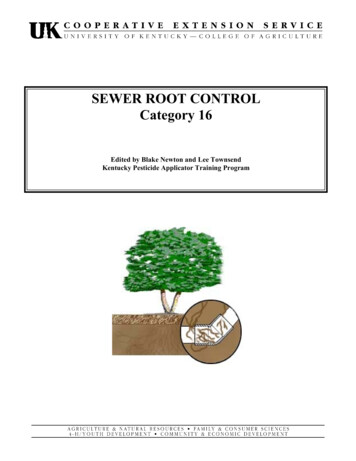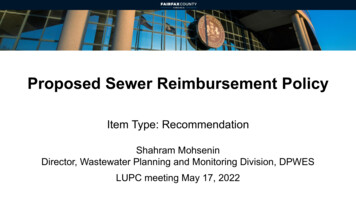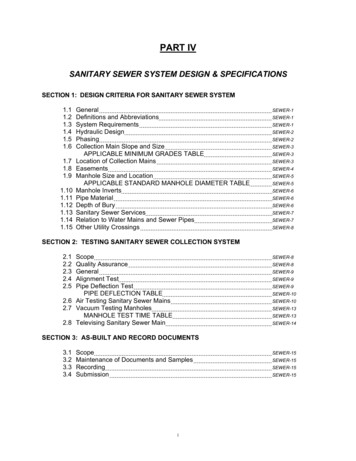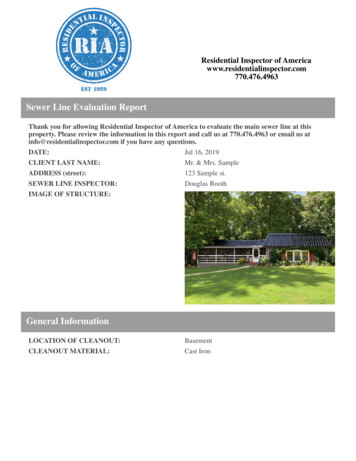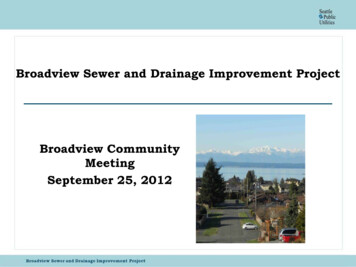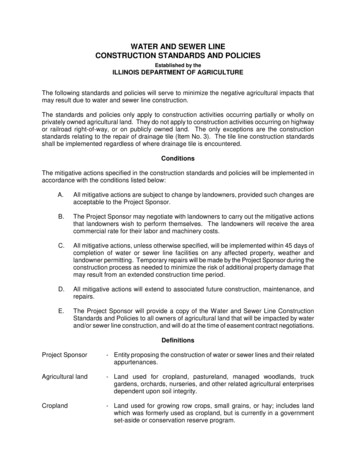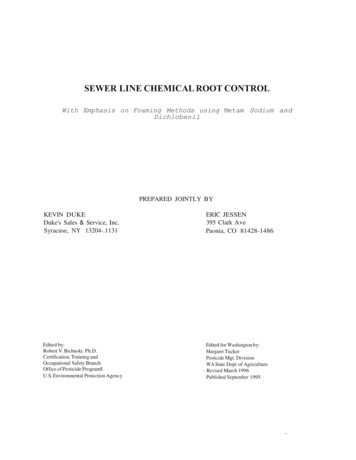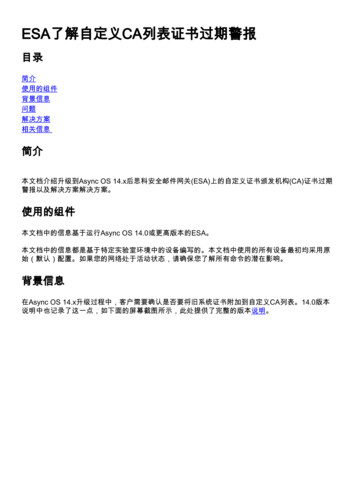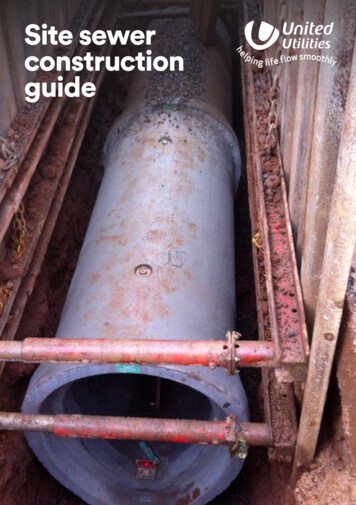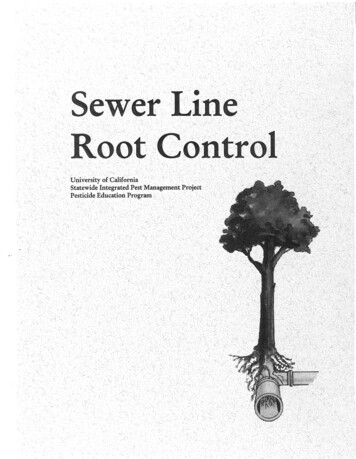
Transcription
Sewer LineRoot ControlPatrick 1. MarerPesticide Training CoordinatorUniversity ofCalifornia, DavisBased on the EPA PublicationSewer Line Chemical Root ControlWritten by Kevin Duke and Eric JessenRobert V. Bielarski, EditorUniversity of CaliforniaStatewide Integrated Pest Management ProjectDivision of Agriculture and natural Resources1996
Ordering Information: This publication can be obtained from the CaliforniaDepartment of Pesticide Regulation upon submission of an application for theQualified Applicator Certificate or License examination in the Sewer Line RootControl category. For further information contact the University of California,Statewide Integrated Pest Management Project, Pesticide Education Program.Mailing Address: IPM Education and Publications, University of California,Davis, CA 95616. Telephone: (916)752-5273. FAX: (916)752-9336.This material is based upon work supported by the Extension Service, U.S.Department of Agriculture, under special project Section 3D, PesticideApplicator Training.To simplify information, trade names of products have been used. No endorsement of named orillustrated products is intended, nor is criticism implied of similar products that are not mentioned orillustrated.The University of Caljfomi in accordance with applicable Federal and State law and University policy, does not discriminate onthe basis of race, color, national origin, religion, sex, disability, age, medical condition (cancer-related), ancestry, marital status,citizenship, sexual orientation, or status as a Vietnam era veteran or special disabled veteran. The University also prohibits sexualharassment.Inquiries regarding the University's nondiscrimination policies may be directed to the Affinnative Action Director, University ofCalifornia, Agricultural and Natural Resources, 300 Lakeside Drive, 6th Floor, Oakland. CA 94612-3560, (510)987-0096.
ACKNOWLEDGMENTS. iiiAcknowledgmentsThis manual was produced under the auspices of the University of CaliforniaStatewide Integrated Pest Management Project through a Memorandum ofUnderstanding between the University of California and the CaliforniaDepartment of Pesticide Regulation. It was prepared under the direction of Frank G.Zalom, Director, UC Statewide Integrated Pest Management Project. This manual is amodification of the 1995 US Environmental Protection Agency publication ApplyingPesticides Correctly: Sewer Line Chemical Root Control-with Emphasis onFoaming Methods Using Metam-sodium and Dichlobenil.Principal ReviewersThe following people provided ideas, information, and suggestions and reviewedmanuscript drafts for this California version.T. Binder, Airrigation Engineering Company, Pleasanton, CAM. Takeda, Department of Pesticide Regulation, Sacramento, CAB. Tieman, Airrigation Engineering Company, Pleasanton, CASpecial ThanksThe following individuals and organizations are gratefully acknowledged forreviewing manuscripts of the original version of this publication and for valuablesuggestions.L. Anderson, EPA Region VII, Lincoln, NEJ. Baker, Idaho Department of Agriculture, Boise, IDP. Baker, University of Arizona, Tucson, AZD. Bishop, EPA Office of Research and Development, Cincinnati, OHBoise City Public Works Department, Boise, IDT. Creeger, Nebraska Department of Agriculture, Lincoln, NEE. Crow, Maryland Department of Agriculture, Annapolis, MDG. Davis, Michigan Department of Agriculture, Lansing, MIT. Edwards, ESS, Inc., Oakland, CAG. Florentine, EPA Regio III, Philadelphia, PA1. Fox, Kansas Department of Agriculture, Topeka, KSM. Grodner, Louisiana State University, Baton Rouge, LAP. Hannan, Washington Suburban Sanitary Commission, Laurel, MDR. Hansen, Minnesota Department of Agriculture, St. Paul, MNP. Houmere, Florida Department of Agriculture, Tallahassee, FLT. Hughes-Lark, Clemson University, Clemson, SCM. Lawson, Virginia Department of Agriculture, Richmond, VAL. Lim, EPA Office of Water, Municipal Support Division, Washington, DCN. Nesheim, University of Florida, Gainesville, FLR. Prewitt, Lexington-Fayette Urban County Government, Lexington, KYL. Quagliaroli, California Environmental Protection Agency, Sacramento, CAC. Rew, Indiana State Chemist's Office, West Lafayette, IN
iv ACKNOWLEDGMENTSB. Scott, South Dakota Department of Agriculture, Pierre, SDJ. Spangler, Lansing Public Service Department of Wastewater, Lansing, MIB. Swingle, Wisconsin Department of Agriculture, Madison, WIB. Tieman, Airrigation Engineering Company, Pleasanton, CAF. Whitford, Purdue University, West Lafayette, INM. Zavala, University of California, Davis, CAThe University of California IPM Project's Pesticide Education Program wishesto thank Diane Clarke for her assistance in preparing this manual.Artists and PhotographersAirrigation Company, Inc., Pleasanton, CA (Figures 2-1, 2-2, 2-4, 2-5, 5-1, 6-4,7-1, 7-2, 7-3, 7-7, 7-9, 7-10, and 7-11)J. Clark, University of California, Davis, CA (Figures 6-8,6-9,6-12, and 6-16)J. Juarez, Sacramento, CA (Figures 1-1, 3-1, 3-2, 3-3, 4-1, 4-2, 4-3, 6-2, 6-3, 0, 6-21, 6-22)D. Kidd, Portland, OR (Figures 6-1 and 6-11)
SEWER LINE ROOT CONTROL
2 PESTS, PESTICIDES, AND REGULATIONSPests 4Pesticide Laws and Regulations 5Federal Insecticide, Fungicide, and Rodenticide Act 5Certification of Pesticide Applicators 5State Pesticide Applicator Certification Programs 6Classification of Pesticides 6Label Directions 6Penalties 6Other Regulations 7Endangered Species Act 7Hazard Communication Standard 7
Pests, Pesticides,and Regulations3
4· PESTS, PESTICIDES, AND REGULATIONSAPesticide may be defined as any substance or mixture ofsubstances intended for preventing, destroying, repelling, ormitigating any pest. It may also be any substance or mixture ofsubstances intended for use as a plant regulator, defoliant, or desiccant.The wise use of pesticides can contribute significantly to the health,welfare, and quality of human life. However, improper use of pesticidescan be a threat to human health and environmental quality.This chapter provides you with a general background in the safehandling of the pesticides used for sewer line root control. Although thismanual focuses on products used for sewer line root control, it includesgeneral information about pesticides, what they are, and how to handlethem safely. For example, a product that is a degreaser may, in itsmarketing material, claim to kill or control roots. Products boasting thisclaim are considered pesticides and are subject to federal and statepesticide laws and regulations.The following sections discuss the differences between general-useand restricted-use pesticides. Applicators using either general- orrestricted-use pesticides must comply with specific federal, state, andlocal rules and regulations that control their safe use. These laws requirethat restricted-use products such as pesticides containing metam-sodiumbe handled by or under the direct supervision of a certified applicator.The laws are designed to protect pesticide handlers, customers, theenvironment, public health, and the systems being treated.PESTSA pest is anything that: (1) competes with humans, domesticanimals, or desirable plants for food, feed, or water; (2) injures humans,animals, desirable plants, structures, or possessions; (3) spreads diseasesto humans, domestic animals, wildlife, or desirable plants; or (4) annoyshumans or domestic animals. Types of pests include: insects such as roaches, termites, beetles, mosquitoes, and fleas insect-like organisms, such as ticks, spiders, and scorpions mollusks, such as snails, slugs, and shipworms weeds, which may include mosses, algae, dandelions, and plantparts such as root intrusions into wastewater collection systems plant disease pathogens such as fungi, bacteria, and viruses thatcause plants to become different from normal plants in appearanceor function vertebrates such as rats and mice and certain birds, reptiles, andfish
PESTS, PESTICIDES, AND REGULATIONS' 5PESTICIDE LAWS AND REGULATIONSAnyone who mixes, loads, or applies any pesticide, cleans or repairspesticide-contaminated equipment, handles empty containers, or worksas a flagger is considered a pesticide handler (Figure 1-1). Several lawsand regulations affect the sale, distribution, and use of pesticides bypesticide handlers. Handlers must be aware of these laws and thepenalties that may be imposed for violating them.Federal Insecticide, Fungicide, And Rodenticide ActFigure 1-1. Pesticide handlersinclude people who mix, load, orapply pesticides and those whoclean or repair pesticidecontaminated equipment, handleempty containers, or work asjlaggers.The Federal Insecticide, Fungicide, and Rodenticide Act (FIFRA)was passed in 1972 and has been amended several times since. Thehighlights ofFIFRA that affect pesticide handlers include:- all pesticide products must be classified as either general- orrestricted-use-handlers must be certified as competent to use or supervise the useof any restricted-use pesticide- two general categories of certification-private applicator andcommercial applicator-are established- all pesticide must be applied according to label directions.Penalties including fines and jail terms are established forviolations- states are given the authority to regulate further the sale or use ofany federally-registered pesticideThe US Environmental Protection Agency was authorized to createregulations that allowed enforcement agencies to carry out theprovisions ofFIFRA. As a result, the EPA set minimum standards ofcompetency for certification of pesticide applicators. This regulation, 40CFR 171 Certification ofPesticide Applicators, allows States and IndianTribes with EPA-approved plans to administer certification programswithin their states.Certification of Pesticide Applicators. Certification is proof thatan applicator knows the correct and safe way to handle restricted-usepesticides. Both private and commercial applicators have to be certifiedto handle or supervise the handling of restricted-use pesticides. Aprivate applicator is anyone who uses or supervises the use of anyrestricted-use pesticide for the purpose of producing any agriculturalcommodity on property owned or rented by the applicator or theapplicator's employer. A commercial applicator uses or supervises theuse of any restricted-use pesticide for any purpose or on any propertyother than as provided under the private applicator definition. A statemay have several different categories of commercial applicator.
6 PESTS, PESTICIDES, AND REGULAnONSState Pesticide Applicator Certification Programs. Each statedesignate pesticide lead agencies to administer its applicatorcertification program. The California Department of PesticideRegulation is one of the state agencies responsible for certification ofpesticide applicators in California and has jurisdiction over applicatorsinvolved in sewer line root control. Commercial pest control firms mustalso be licensed by the Department of Pesticide Regulation or other stateagencies, depending on the type of pest control they perform. Thesefirms must have certified applicators on staff and all pesticides,regardless of classification, must be applied by or under the supervisionof a certified applicator.KEEP OUT OF REACH OF CHILDRENDANGERPOISONFigure 1-2. Pesticide handlers requirespecial knowledge and training to usehazardous pesticides.Classification of Pesticides. Manufacturers must register everypesticide with the USEPA and the California Department of PesticideRegulation. By statute, all uses must be classified by EPA either asgeneral- or restricted-use. Pesticides that are not likely to harm humansor the environment when used according to label directions are classifiedfor general use. Those that have more potential for harming humans orthe environment than general use pesticides and require specialknowledge or training to assure correct application are classified forrestricted use. Restricted-use pesticides may only be applied by or underthe direct supervision of certified applicators (Figure 1-2).Label Directions. You may not use any pesticide in a manner notpermitted by the product's label. A pesticide may be applied only to theplants, animals, or sites specified in the directions for use. You may notuse higher dosages, higher concentrations, or more frequent application.You must follow directions for use, safety, mixing, diluting, storage, anddisposal, as well as any restrictions.Penalties. Any commercial applicator who violates provisions ofFIFRA may be assessed a penalty of not more than 5,000 for eachoffense ( 1,000 for private applicators). Before enforcement agenciesimpose fines, applicators have the right to ask for hearings in their owncities or counties. Any applicator who knowingly violates any provisionofFIFRA shall be fined not more than 50,000 and/or given up to oneyear in prison ( 1,000 and/or 30 days in prison for private applicators).Additional penalties may be levied under California laws.Other RegulationsIn addition to FIFRA and California pesticide laws, you should befamiliar with a number of other regulations such as those listed below:
PESTS, PESTICIDES, AND REGULATIONS· 7Figure 1-3. Before making anypesticide application, you must besure no endangered species arelocated on or immediately adjacentto the site to be treated.Endangered Species Act. The Endangered Species Act is a federallaw designed to protect plant and animal species that are in danger ofextinction. The EPA in cooperation with other federal, state, and countyagencies have established limitations on the use of certain pesticides inspecific areas known to harbor endangered species, Prior to making anypesticide application, you must determine that endangered species arenot located on or immediately adjacent to the site to be treated (Figure 13). If in doubt contact the regional US Fish and Wildlife Service Officeor the nearest California Department ofFish and Game office. Note:sewers may not be devoid of endangered species. It is reported that theendangered Gray Myotis bat is present in the city sewers of Pittsburg,Kansas.Hazard Communication Standards. Regulations administered bystate and federal Occupational Safety and Health Administrations(Federal OSHA and Cal-OSHA) require employers to provide protectionto workers who may be exposed to hazardous chemicals under normaloperating conditions or in emergencies. The regulation requiresemployers to: make list of hazardous chemicals in the workplace obtain material safety data sheets (MSDS) for all hazardoussubstances on their lists ensure that all containers of hazardous materials are labeled at alltimes train all workers about hazards in their workplaces and documenttraining keep files (including the MSDSs) on the hazardous chemicals andmake them available to workers
8 ROOTS IN SEWERSRoot Growth 10Root Systems 11Factors Influencing Root Growth 11Roots in the Sewer Environment 13Identifying Sewer Line Root Problems 13Maintenance Histories 13Sewer Line Video Reports 14Commonalties in Root-prone Areas 14Root Control Methods 15Non-Chemical Control 15Planning 15Physical Control 15Mechanical Control 16Chemical Root Control 17Trifluralin 18Copper Products 18Metam-sodium and Dichlobenil 19Sodium Hydroxide and 2,6 Dichlorobenzonitrile19
Roots in Sewers9
10 ROOTS IN SEWERSIntrusion of roots into sewers is probably the most destructiveproblem encountered in a wastewater collection system. Root-relatedsewer problems include: sewer stoppages and overflows; structuraldamage caused by growing roots; formation of septic pools behind rootmasses (which generate hydrogen sulfide, other gases, and odors);reduction in hydraulic capacity and loss of self-scouring velocities;infiltration in areas where pipes are seasonally under a water table; andexfiltration of sewage into soils around cracked or separated joints.Sewer stoppages and overflows are the way that most municipalitiesand homeowners find out about their root problems. Structural damage,on the other hand, usually goes unnoticed until the damage is verifiedthrough video probing. In the long run, structural damage is probablymore costly than sewer stoppages. Effective use of early, preventive rootcontrol can avoid costly and permanent structural damage. However,municipalities are unlikely to fund preventive root control programs butusually wait until identified problems alert officials to the need forcontrol.ROOT GROWTHRoots have three basic functions: (1) they anchor the plant and holdit upright; (2) they store food for the plant; and (3) they absorb andconduct water and nutrients.Roots are tenacious and long-lived. Aboveground plant parts dependon root systems for survival (Figure 2-1). Most plants can regenerateafter having been topped but none can survive the loss of their rootsystems. For example, a willow tree root system can survive for manyFigure 2-1. The aboveground parts oftrees depend on elaborate root systemsfor survival. Rootscan travel hundreds offeet to moisture and nutrients.
ROOTS IN SEWERS' I Jyears after the top has been removed and will continually try sending upnew shoots through the stump or exposed roots. The root systems ofsome grasses are thought to have remained alive for thousands of years.Just how far roots will grow in search of moisture and nutrients isuncertain. However, in the Rocky Mountains of Colorado, live tree rootshave been found penetrating a pipe in the Moffet tunnel, 2500 feet fromthe nearest tree.Root SystemsPlants may have either fibrous or tap root systems. Plants withfibrous root systems, such as garden plants and grasses, occupy theupper layers of soil and extend outward. These types of root systems notnormally associated with sewer problems.Figure 2-2. Plants with tap roots, such as trees and woody shrubs, can invade sewer pipes. Theseroots can exert enough pressure to spread pipe joints and break pipes.Plants with tap root systems include trees and woody shrubs. Theprimary roots of these plants grow downward into the soil. Tap rootsystems are well adapted to deep soils and soils where the water table isrelatively deep. Branches, or secondary roots, grow laterally from theprimary root. Secondary root structures can grow to several inches indiameter. If these invade sewer pipes, they can exert enough pressure tospread pipe joints or break pipes (Figure 2-2).Feeder roots are fine, hairlike roots that may develop into secondaryroots. The surfaces of feeder roots contain microscopic structures calledroot hairs. Root hairs greatly increase the total surface area available toabsorb nutrients and water.Factors Influencing Root Growth. Little is known about thegrowth rate of tree roots. However, root growth in deciduous trees is
12· ROOTS IN SEWERSgenerally greatest in fall, winter, and spring before leafing. During thesetimes roots are either storing or distributing nutrients. Root growthbecomes less active in the late spring and summer seasons whenaboveground portions of trees are growing. Roots respond to moisture,nutrients, and soil temperatures. The leading tip of root shoots, themeristem, can detect and grow toward nutrients and moisture. Thistendency for roots to grow toward moisture is called hydrotropism. Aswater tables drop, tree roots grow deeper in search of moisture. Whensoil moisture is depleted roots begin to wilt and will eventually die.Roots are always growing because parts of the root system areconstantly dying as they deplete nutrients or moisture in an area of soil.Figure 2-3. Urban environments often do not provide adequate water or nutrientsfor tree growth.Tree roots seek out other sources, including sewer lines.In urban environments, good sources of nutrients and moisture fortree roots may be scarce. Much of the soil surface is covered withconcrete and asphalt (Figure 2-3). Leaves and other organic debris fromlawns and landscaped areas are hauled away, preventing these materialsfrom increasing soil nutrient levels. Storm sewers drain surface wateraway from planted areas, reducing available sources of water for plantroots. These factors cause tree roots to seek water and nutrition atgreater depths or from other sources.Moisture and warm temperatures surrounding sewer pipes createexcellent environments for root growth. Temperature variance betweenwastewater flow within the pipes and surrounding soil may causecondensation to form on outer pipe surfaces, providing a source ofmoisture. Backfill used during sewer construction may provide morefavorable soil for root growth than surrounding undisturbed soils. Also,loose pipe joints, cracks, and pipe porosity allow water with highnutrient content to seep from the pipes into surrounding soils. Sewerlines above the water table will draw roots in that direction. Duringcolder seasons, especially where ground frost occurs, warmer soiltemperatures surrounding sewer pipes may attract tree roots.Heavy secondary root structures may follow sewer pipes for many feet,exploiting each opportunity to penetrate them. Even microscopicopenings only a few cells wide permit hairlike root structures from theseroots to penetrate pipe joints, cracks, connections, or any other openings(Figure 2-4). Once they gain entry, roots thrive in sewer pipes becausesewer pipes usually provide a perfect hydroponic environment-roots
ROOTS IN SEWERS' 13Figure 2-4. Hairlike roots can entermicroscopic openings in sewer pipes. Onceinside, they rapidly grow to exploit thewater and nutrients.are suspended in a well-ventilated, oxygen rich atmosphere with aplentiful supply of water and nutrients.Roots of most trees cannot grow or survive if constantly submerged.Therefore roots generally do not cause problems in sewers that arelocated below a permanent water table. With adequate water available,roots need not expend energy trying to penetrate the water tables andsewer pipes. However, if a water table fluctuates, or if porous soilprofiles permit rapid downward drainage of rain water, roots can befound in saturated soils and can be a major cause of sewer infiltration. Inthese cases, tree roots suspended in the atmosphere of sewer lines cancarry on metabolic activity while the woody, submerged portions of rootsystems serve as pipelines for plant nutrients.Roots in the Sewer Environment. Several types of root structuresare found in sewer lines. Veil type root structures occur in lines withsteady flows, such as interceptor pipes and other constantly flowinglines. Roots penetrate these pipes at the top or sides and hang from uppersurfaces like curtains, touching the flow. Live roots are seldom foundbelow the water level within pipes with steady flows. These hangingroots rake the flow and accumulate solids and debris. Grease and otherorganic materials also accumulate. Eventually root masses andaccumulated materials cause flows to stop. In these situations, gassesmay develop in the sewer lines.Tail type root structures occur in sewers that have very low orintermittent flows, such as in small diameter collector sewers, buildingsewers, and storm drains. Tail root structures look like horse tails. Theroots grow into the pipes from the top, bottom, or sides, and continue togrow downstream filling the pipe. Tail root structures over 20 feet longhave been removed from sewer lines. Such root structures may appear assolid tubes of tree root, possibly with a slightly flattened area along thebottom where submergence in sewer flows prevent root growth.Roots that enter sewers and those visible during a video inspectionof sewer lines represent only a small percentage of the total rootstructures in the vicinity. Roots girdling the pipe on the outside are alsoresponsible for pipe damage because they can enter joints and cracks andcause breakage as they swell.IDENTIFYING SEWER LINE ROOT PROBLEMSIn sewer line root control, you are confronted with the problem ofdetermining which sewer lines have been infiltrated by roots. Severalindicators are available for determining which collection lines have rootpenetration. Use the following information to help you identify rootinfiltration problems:Maintenance Histories. Maintenance records will show whichsewer lines have experienced stoppages and the causes of these .
14· ROOTS IN SEWERSSewer Line Video Reports. If sewer lines have been examined withvideo cameras, the video tapes will provide documentation of rootproblems and help you make assessments of the extent of infiltration.Commonalties In Root-prone Areas. Generally, sewer lines in thesame area that were installed at the same time and have similar treeplanting patterns will experience similar root problems.PREDICTING SEWER LINE PROBLEMSConditions which increase the likelihood of root problems in a particular sewer section include: sewers located near other sewers with known root problems sewer pipes located near the surface and closer to tree roots sewer lines located off-road in wooded easements or at curb lines near trees and roots sewer lines located along tree-lined streets and easements sewer lines with many lateral connections per lineal foot (these afford greater opportunities for rootintrusion) sewer lines located in residential areas (residential sewer lines are more susceptible to root problemsthan those in industrial areas) sewer lines constructed with loose-fitting joints or out-dated joint packing materials (asbestos-cementpipes, orangeburg pipes, and clay tile sewers with oakum joints are very susceptible to root penetrationwhile systems with air-tight rubber gaskets and seamless pipes are less susceptible)A useful tool for planning root control programs is the scattergram.This is a map of a sewer collection system with known root problemlines highlighted. As root-related stoppages occur, or if other evidenceof root problems is detected, the line is highlighted on the map. Overtime, patterns begin emerging that will indicate areas which are rootprone (Figure 2-5).Figure 2-5. Marking problem areas on a sewer system map can assist in planning root controlprograms. This map is known as a scattergram.
ROOTS IN SEWERS' 15ROOT CONTROL METHODSA successful sewer line root control program will integrate a varietyof root control methods. This includes non-chemical control methodssuch as planning and management during sewer line construction,physical control procedures, and mechanical root removal. Nonchemical methods are usually augmented with chemical control methodswhen necessary. Chemical control involves the use of certain herbicides.Non-Chemical ControlSeveral non-chemical methods of sewer line root control areavailable to root control experts and public works officials. Althoughnon-chemical methods generally do not provide the same level of resultsas chemical methods they have an important place in sewer linemaintenance. For example, mechanical methods are best for openingplugged sewers and for removing roots from sewers that are at imminentrisk of plugging. Pipe re-lining, grouting, and sealing may deterintrusion by roots. Proper planning during design and installation ofsewer lines may discourage root problems.In some cases chemical control methods should not or cannot beused. For instance, chemicals are not normally applied to sewer linesthat are near treatment plants. Also, herbicide use may be restricted dueto environmental or safety considerations.Planning. Proper planning during sewer line design andconstruction is a practice that can prevent or minimize tree root invasionproblems. Root problems are reduced by: (1) carefully installing andinspecting sewer lines during construction to assure all joints areproperly sealed; and (2) controlling the selection of tree species andplanting sites near sewer lines. Sewer connections with air-tight jointsand seams make it difficult for roots to penetrate. Municipalities shouldpay special attention to and carefully inspect connections whereplumbers join building laterals to the mainline sewer to be sure these aretight. Also, homeowners should be advised of the potential for futureroot problems and should be discouraged from planting deep-rooted orfast-growing trees near sewer lines. Willow trees in particular haveadventurous and thirsty roots and can cause serious sewer line problems.Physical Control. Physical control of sewer line roots involvesisolating the environment of the sewer pipe from roots that could causeproblems. Examples of physical control include tree removal, sewer pipereplacement, and pipe relining.Tree removal works best when removing a single troublesome treesuch as a willow whose roots have invaded sewer pipes. Unfortunately itis often difficult to convince homeowners to remove trees in the vicinityof sewer lines. This is not only expensive but does not guarantee an end
16 ROOTS IN SEWERSto root problems. Roots may survive long after removal of abovegroundtree parts, necessitating the use of mechanical or chemical controls forsome time afterward. For tree removal to be most effective, stumpsshould be removed or chemically treated with a basal applicationherbicide.Pipe replacement involves removing old, defective sewer lines andreplacing them with new pipes. As discussed above, the new lines musthave air-tight joints and properly installed connections in order toprevent tree roots from becoming problems. Pipe replacement correctsstructural defects as well as existing root problems. Major disadvantagesto pipe replacement include cost, disruption of traffic and property, andthe destruction of trees and shrubs planted in the vicinity of the trenchline. Also, roots can still enter the newly installed line through olderlateral lines coming from buildings. If existing sewer pipers are indanger of collapsing or are in a state of structural failure, pipereplacement may be the best method of control. Pipe replacement is notwarranted, however, when sewer lines are in sound s
Zalom, Director, UC Statewide Integrated Pest Management Project. This manual is a modification ofthe 1995 US Environmental Protection Agency publication . Applying Pesticides Correctly: Sewer Line Chemical Root Control-with Emphasis on . offense ( 1,000 for private applicators). Before enforcement agencies impose fines, applicators have the .
